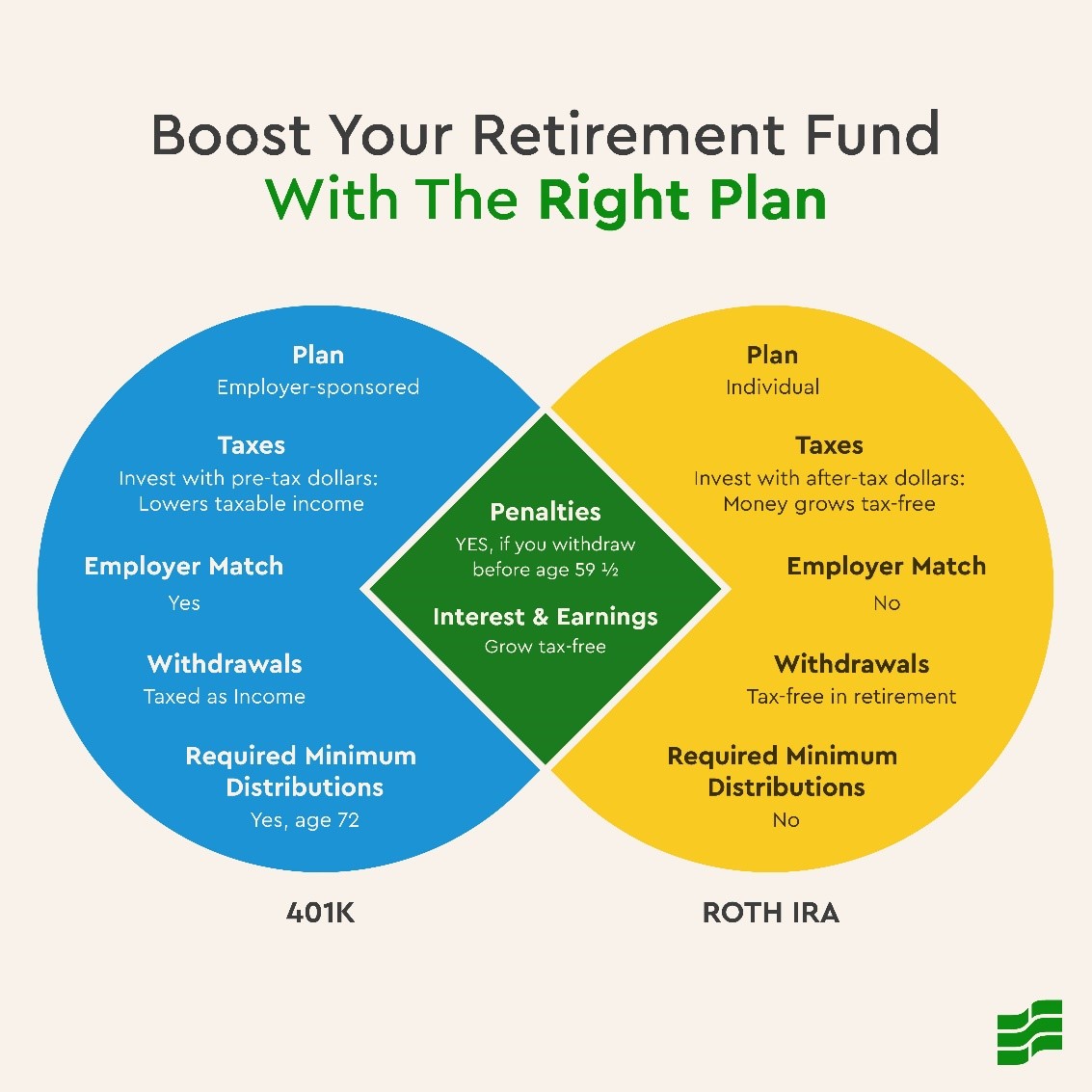Will Getting a Small Business Loan Affect Your Mortgage Approval

 Meg Schutte
Apr 22, 2021
Meg Schutte
Apr 22, 2021

Freedom and cash, these are two things you’ll want most when you finally retire. How much you will need depends on your future lifestyle goals and how you plan to pay for them. It’s all dependent on what you’ve saved during your career, what you can expect to draw during retirement, and any strategies you have in place to keep earning money while you kick back. Plus, you’ll need to factor in the increasing costs of living and health care expenses, and that people are living longer. The goal is to do everything you can, now and later, to build and grow a healthy retirement portfolio.
This guide will help you understand the different plans available based on your type of employment and current financial situation. We’ll also dive into retirement investment funds and smart saving tactics so you can live comfortably both today and in the years to come.
Participate in a 401(k) - Never leave money on the table. If your employer offers a Traditional 401(k) savings plan, put the maximum percentage that you can into your account. Set up an automatic deduction from your paycheck on Day 1. Keep that money out of your hands and earning more in the background. If your company matches contributions – this is free money they’re giving you – find out when you’re fully vested and can claim any employer match. Most 401(k)s are tax-deferred, so your contributions will reduce your taxable income for the year, but you will pay taxes on your distributions. If you leave your job, you can take your 401(k) with you or leave it where it is. However, growing in popularity are Roth 401(k)s, where your contributions don't reduce your taxable income now, but your distributions are tax-free later.
If you leave your job, you take your 401(k) with you or leave it where it is. It's also possible to transfer an employer-created 401(k) to a SEP IRA if your career path shifts.
For Self-employed/Small Business Owners:
Fund a SEP – When you work for yourself, you don’t have the luxury of an employer-sponsored retirement plan, but you can still contribute to a SEP IRA (Simplified Employee Pension) with more generous yearly contribution allowances. Similar to traditional IRAs, your contributions are tax-deductible in the year you make them, helping to save you money on your taxes.
If you’re a business owner or a sole proprietor, check out Choosing a Retirement Plan that Fits Your Business.

Good news, you don't have to limit your retirement savings to just one of the above; you can supplement your 401K or SEP IRA with all of the below.
Open an IRA - Working with a broker, you can choose from various retirement investment options – more so than most employer-sponsored plans, and should aim to contribute as much as you can each year. You can select a Traditional or Roth IRA based on which one will give you better tax advantages:
Traditional IRAs are funded with pre-tax dollars, so they lower your taxable income for the year and you pay taxes on distributions. Contributions are not limited by annual income.
Roth IRAs use after-tax dollars, so contributions have no effect on your taxes, but you can withdraw savings tax-free in retirement. Limits and eligibility are based on your modified adjusted gross income (MAGI), depending on tax-filing status.
Note: You can set up a Roth IRA for anyone in your family who has earned income.

Beyond putting your money into retirement plans, or typical high-yield savings, CD and money market accounts, you can invest in financial products like stocks, bonds, and mutual funds. You can choose the specific stocks and investments you want to buy, invest in diversified funds based on your desired retirement year and risk level, or work one-on-one with a professional. We’ll further explore your possibilities later in the piece.
Stocks: When you buy a company's stock, you’re getting equity in the business, and as a “shareholder,” share in their profits. Stocks are sold on public exchanges like NASDAQ and the New York Stock Exchange. The value of a stock increases or decreases based on the success of the company. When the stock price goes up, you can sell it for a profit. You can also earn shareholder dividends, typically paid out on a quarterly basis. There is always a risk that a company can lose value or go out of business, and then you may lose all or part of your investment. But when the market or stock is in good shape, you can enjoy big gains.
Bonds: With bonds, you’re basically loaning a company or government money to help them do business. So they are in debt to you, and will pay you interest on the loan for a set timeframe – which can range from a few days to 30 years. These fixed income payments can be added to your retirement cash flow. Again, there is risk: if the company goes bankrupt, you’ll stop receiving interest payments and might not regain your full principal. If you hang on to a bond until full maturity, you will receive the face value of the initial bond and any interest that hasn’t been paid out to date.
Mutual Funds: This type of investment sounds like its name: it’s a professionally managed investment portfolio that allows you, along with other investors, to pool your money to invest in a collection of assets, like stocks, bonds and securities. It’s like buying pieces of lots of different companies and your returns (or losses) are related to the overall value of the funds’ performance. Share purchases are final after the close of market. It’s a simpler way to invest, with fund managers making choices for you. And mutual funds liquidity makes them easier to buy and sell.
Certificates of Deposit(CD): A topic that will come up throughout this article is the concept of risk. As adults grow closer to their senior years or are post-retirement, they’ll want to increasingly favor more conservative funds and investments.
The beauty of CDs is that they present no risk, only the guarantee of interest. You choose how long you want the money to sit (such as 12 months vs. 18) and can view the rate of return upfront, helping you make an informed decision. Better yet, Bank of Hope offers five different options, including an IRA Certificate of Deposit geared specifically toward funding your retirement. To learn more, read our guide to certificates of deposit in which we answer common questions about CDs.
It’s important to recognize that stocks, bonds, CDs, and mutual funds are the building block of any retirement plan. Each comes with its own pros and cons which shift as you age.
After all, there’s more risk in playing the market, but also great returns if you hit it big. When you’re younger, you can afford to take larger gambles, as the stock market will theoretically improve with time, even if there are temporary dips. You won’t need the money you invest in your 20s for 40+ years!
On the other hand, if you are in your 50s, you’ll need that money sooner, and one dip in the market could mean the dollars you invested today could lead to losses rather than gains.
Some experts suggest subtracting your age from 110 to determine how much to invest in stocks. For example, if you’re 60, you would want to allocate 50% stocks and 50% to bonds. The goal is to diversify your portfolio, minimize fees, and make choices that match your tolerance for risk. If you can ride out marketplace volatility and leave your investments alone – remember, you’re in this for the long haul – these options might be right for you.
Log into your 401(k) portal or talk to a wealth advisor, and you’ll be confronted with a few brief questions. What is your desired year of retirement? What is your preferred amount of risk versus reward? Knowledge in hand, you’ll be pointed towards specific mutual funds for individuals just like yourself.
The assigned wealth advisor will make informed investment decisions keeping the qualifying criteria in mind. The best part is that, if the fund is designed to reflect your target retirement year, the manager will gradually make the strategy more conservative as the years progress. In turn, you don’t have to micromanage your retirement funds.
The above-mentioned target-date mutual fund strategy is far from being your only choice; other options include equity funds based on company size, index funds (such as the S&P 500) money market funds, bond funds, and commodity funds. Remember, you can diversify your retirement investments across multiple funds.
Push Back Social Security Benefits: As America’s pension plan, Social Security is designed to provide you income during retirement years. You have been paying into the system your whole career and when you retire, it’s time to collect. While you can begin taking benefits at age 62, it’s best to wait until you reach full retirement age, which is either 66 or 67, depending on the year you were born. Even more advantageous, your benefit will increase 8% each year, up until age 70. So the longer you hold off, the more you will have to put into your pocket. For example, if you begin drawing benefits at age 62, and your full retirement age is 66, your benefit would be reduced by 25%. Wait until age 70 and collect 132% of your monthly benefit.
Note: To get an idea of what your Social Security payment might be, visit ssa.gov. Use the retirement benefit estimator to see what you can count on in retirement.
For about half of elderly Americans, Social Security is at least 50% of their income; for close to 1 in 5 married couples and nearly half of single seniors, it's 90%.

Invest in You: Keep Working: Retirement isn’t for everyone. A lot of people like having a job, something to do, a place to go, and people to socialize with... not to mention there’s a lot of comfort in still collecting a steady paycheck and benefits, especially healthcare. Ask your employer if you can go part-time or stay on as a consultant. Or start a side hustle or new career in an entirely different field for a monthly draw. If there’s a way to stretch your savings over your retirement years, by all means – do it!
Whatever your retirement goals, an experienced Wealth Advisor at Bank of Hope Investment Services* can help you develop and implement a retirement strategy. Compare and choose key financial products, retirement funds, and services to get you where you want to go in your golden years.
*Securities and insurance products are offered through Cetera Investment Services LLC (doing insurance business in CA as CFG STC Insurance Agency LLC), member FINRA / SIPC. Advisory services are offered through Cetera Investment Advisers LLC. Neither firm is affiliated with the financial institution where investment services are offered. Advisory services are only offered by Investment Adviser Representatives. Investments are: *Not FDIC/NCUSIF insured *May lose value *Not financial institution guaranteed *Not a deposit *Not insured by any federal government agency.
Meg Schutte is a Bank of Hope Blog contributor.
The views and opinions expressed in this article do not necessarily represent the views and opinions of Bank of Hope.


